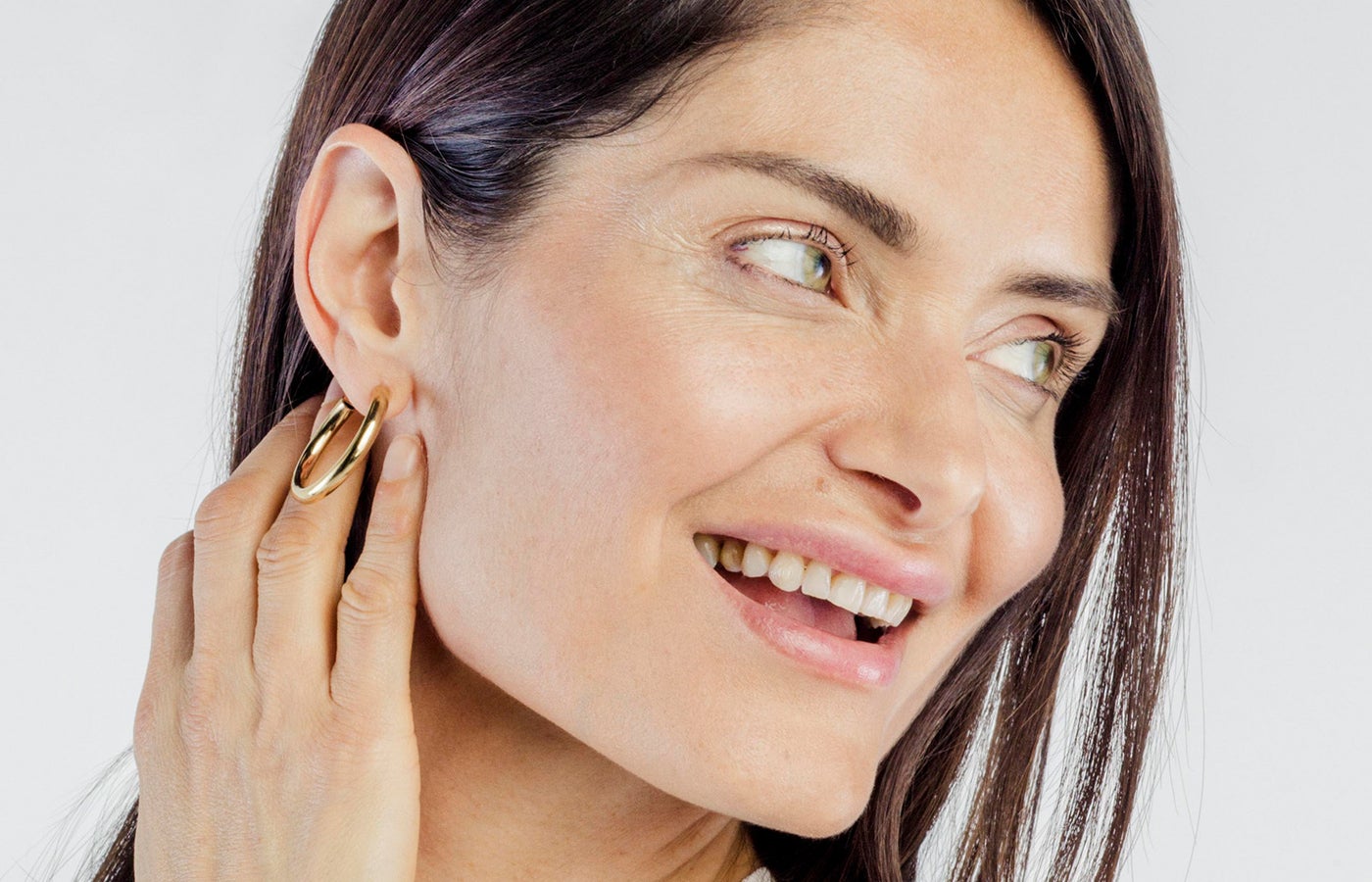Invisalign treatment uses a series of removable clear aligners to straighten teeth and correct gaps, crowding, and mild bite issues.
This alternative to traditional metal braces uses flexible plastic aligner trays made from a thick, flexible material called SmartTrack. The aligners fit snugly over your teeth to gradually adjust their position. They’re worn 24/7, except for when eating, drinking, or brushing your teeth.
Invisalign’s clear aligner system is an orthodontic treatment option for older kids, teens, and adults. One of the key benefits of Invisalign is that they’re less noticeable than metal braces.
Studies show that Invisalign works to:
- straighten crooked teeth
- correct malocclusion (crowded teeth)
- correct some underbites, open bites, and crossbites
Studies vary on whether Invisalign is the best treatment option to fix overbites and complex cases. If you have severe bite issues, your orthodontist may recommend traditional braces.
Pros
- Clear aligner treatment is less noticeable than metal braces.
- Treatment time is usually about 6 months shorter, too.
- Seeing digital predictions of your tooth movement and results can be a strong motivator for sticking with your treatment plan.
- You’ll still be able to eat whatever you want when you take out your trays. (With traditional braces, you'd have to avoid sticky foods, candy, gum, and hard foods like apples that could damage the metal brackets.)
- You can keep brushing and flossing as you would normally, which helps keep your mouth and teeth cleaner than with metal braces. In fact, many cosmetic dentists provide teeth whitening gel to apply in your Invisalign trays.
- You won’t have to worry about brackets or wires coming loose.
- Invisalign can help facilitate better oral hygiene, “improving periodontal status and causing a decrease in plaque levels, gingival inflammation, bleeding upon probing, and pocket depth,” according to a 2019 study.
- Invisalign’s SmartTrack material is said to be more durable than competitors like ClearCorrect.
- Reviewers on RealSelf give this treatment option a 81% Worth It Rating, with many saying they went from hiding their teeth to smiling confidently in Invisalign before and after photos.
Cons
- Like all braces, this isn't a quick fix. Treatment time averages about 12 months.
- It’s a real commitment: the treatment is only effective if you wear the aligners consistently, for an average of 22 hours a day.
- Unless you’re simply drinking clear, cold liquids, you’ll have to remove your aligners before eating or drinking, and then brush and floss your teeth before you put the trays back in afterward.
- It can be uncomfortable, especially during the first day or two with a new set of aligners. Each tray fits the alignment your teeth will have after you’ve finished wearing it for two weeks, so it will be snug and hard to get in and out when you first start wearing it.
- Most people need “attachments”—tiny, teeth-colored bumps that are bonded to teeth and click into the aligners to help them make more complex movements—for the full course of treatment. Attachments aren’t as noticeable as metal braces, but they’re still visible.
- Invisalign aligners can have sharp edges that may irritate the inside of your cheeks, lips, and tongue, causing tenderness and sometimes canker sores. Some RealSelf reviewers recommend gently sanding down the edges with a small nail file, while others say that didn't work for them and swear by dental wax.
- As with metal braces, you’ll need to wear a retainer post-treatment to maintain your new smile.
- The cost of Invisalign can exceed the price of metal braces.
- Average Cost:
- $4,820
- Range:
- $3,200 - $6,700
Your treatment cost will depend on its complexity, your provider's credentials, their location, and whether your dental insurance plan includes orthodontic coverage.
Most dental healthcare providers offer payment plans or accept financing solutions like CareCredit, to help make Invisalign costs more manageable. If you have a flexible spending accounts (FSA), you may also be able to pay for Invisalign using those tax-free dollars.
The Invisalign photos in our gallery have been shared by the provider who performed the procedure, with the patient's consent.
Here’s what to expect during your treatment and how it works to straighten teeth.
- At your first appointment, your provider (or a trained technician in their office) will complete a 3D digital iTero scan of your teeth or a traditional putty impression of your teeth. Your dentist or orthodontist will evaluate your current tooth alignment and oral health, to make sure you're a good candidate. Then they'll create a customized treatment plan.
- Your first batch of aligner trays will be 3D printed and mailed to your dentist’s office within a few weeks.
- At a follow-up appointment, your provider will show you an animated visualization of your tooth movement and final result. You’ll pick up your first series of aligner trays, returning every month or so to pick up more and have a quick check-up on your progress. Each set of aligners will be slightly different, making small adjustments to your teeth’s position to gradually shift them into place. They'll move about 0.25 mm with each set of trays.
- You’ll wear each set of aligner trays for one to two weeks before moving on to the next. The aligners have to be worn for 22 hours a day—essentially all day and night, except to clean them, eat, and brush and floss your teeth.
- To make room for straighter teeth, your provider may need to carefully remove a small amount of enamel between select teeth. You'll still be left with enough enamel, but slightly slimming adjoining teeth creates just enough space to bring them into alignment.
- They may also bond attachments to your teeth to serve as tiny “handles” for the aligners. Ninety percent of Invisalign patients have some attachments for the duration of treatment, and 40% need them on the front four teeth. Studies show they help move teeth more precisely and efficiently, which speeds up treatment time.
- “Some cases can be completed without the need for attachments," says Dr. Steven Davidowitz, a cosmetic dentist in New York City. "However, in most cases, refusing attachments will not allow full, ideal alignment, and it may prolong your treatment.” Dr. Victoria Veytsman, a cosmetic dentist in New York City, agrees that attachments are well worth getting if they're included in your treatment plan.
- At the end of your prescribed treatment course, your dentist may recommend a short series of “refinements” to further tweak teeth that haven’t moved as anticipated. These trays are included in the initial cost of treatment.
RealSelf Tip: Removing Invisalign trays can be frustratingly difficult at first. It’s possible to break a tray if you twist it or pull too hard, so take your time until you get the hang of it. You can find affordable clear aligner removal tools online, but they’re not essential. Try starting at the very back of one of your bottom trays, slipping your thumbnail under the edge and lifting up, going from tooth to tooth. Eventually the tray will begin to pop out. It also gets easier over time to take out your Invisalign trays.
It’s important to take out your Invisalign aligners before you eat or chew gum. You’ll also need to floss and brush (or at least rinse) before putting your aligners back in, as food trapped under the aligners can lead to tooth decay.
You can keep your aligners in if you’re drinking water or a sugar-free, clear sparkling water (like seltzer), but drinking alcohol, juices, milk, or soda with your aligners in is not recommended, since they have sugar and acids that can eat away at your teeth.
Hot beverages like tea or coffee can stain or warp your aligners, and even colored cold drinks can stain them.
RealSelf Tip: You may notice that your teeth aren’t as bright after Invisalign treatment. If you don’t rinse your mouth or brush your teeth before putting your aligners back in after eating, it can dull the teeth and make them a little yellow, says Dr. Davidowitz. That’s why, he says, “teeth whitening after Invisalign is always the cherry on top.” Teeth whitening gels can be used in your Invisalign aligners and your retainers.
Invisalign treatment time can range from 6 to 18 months, depending on how much your teeth need to move. Some people start noticing a difference from Invisalign in as little as two weeks, while others may need up to six months to start seeing results.
There are ways to speed up tooth movement. Ask your Invisalign provider if they offer AcceleDent or Propel, devices that stimulate the bone and roots to deliver 50–70% faster results and reduce discomfort. The only downside is the cost: AcceleDent is expensive, and insurance doesn’t cover it.
Results can be permanent, as long as you're willing to wear a retainer.
When you and your doctor are happy with the position of your teeth, you’ll get a retainer that matches your last set of aligners. Your Invisalign results will last for as long as you wear your retainer. “People always ask how long they have to wear the retainer. My answer is, for as long as you want to have straight teeth,” says Dr. Davidowitz.
There are several types of retainers, though most patients get Vivera, made by the company that also makes Invisalign.
Providers recommend wearing your retainer full-time for three months and every night after that.
Each new set of aligners can hurt a bit at first, says Dr. Veytsman. “The first few days of having something foreign in your mouth are always an adjustment.”
The trays take a few days to really settle in and fit well. Biting on gauze or cotton throughout the day can help seat them properly. You can also buy Aligner Chewies, small cylinders made of a soft spongy material, or Movemints Clear Aligner Mints, sugar-free edible alternatives.
You may also feel some pressure or soreness in your jaw as the aligners slowly move your teeth. It’s most noticeable when you first switch to a new aligner.
“When I received my first tray, the pressure was very intense, especially for the first few days. I dreaded taking them out to eat,” says RealSelf member Tori Needam, 41, of Trenton, Ohio. “Changing the trays at night helped, and so did taking some Advil before I went to bed.”
The soreness should ease as your teeth shift into their new position.
As we mentioned above, some people also develop canker sores from the sharp edges on the trays. If you start noticing pain or feeling that the inside of your mouth is raw, try gently sanding down these sharp edges or using dental wax to cover the edges.
RealSelf members give Invisalign a Worth It Rating of 81%, higher than any other type of clear braces.
Those who rated it “Not Worth It” said that the aligners didn’t correct their teeth enough, given the level of discomfort and hassle over a lengthy treatment time.
Express treatment offers five-, seven-, and 10-aligner “packages” to make minor corrections at a lower cost.
With Express, “the clinical situation needs to be minuscule to very mild tooth movement, like that typically associated with recent minor relapse from past orthodontics,” says Dr. Davidowitz.
Your dentist will determine which option is right for you. But don’t be surprised if you’re not a good candidate. Dr. Davidowitz says that he rarely offers Express, “as it limits the stages to get to a result I’d find acceptable in a great majority of cases.”
You may also want to consider these cosmetic dentistry and orthodontic options.
- Traditional braces use wires and metal brackets to apply pressure on teeth and move them. They may take longer than Invisalign, but they can correct more complex alignment and bite issues. They also have a higher Worth It Rating than any clear aligner.
- Porcelain veneers are thin, custom-made shells that permanently attach to the front of your teeth, to correct minor alignment issues and create a brighter smile. Their Worth It Rating is almost as high as Invisalign.
- Lingual braces (sometimes called iBraces) are similar to traditional braces, but they’re boned to the backsides of the teeth, so they’re hidden from view. They’re gaining popularity because of their aesthetic advantage, but this type of treatment tends to take the longest because the teeth move so gradually. They have a significantly lower Worth It Rating than both traditional braces and Invisalign.






